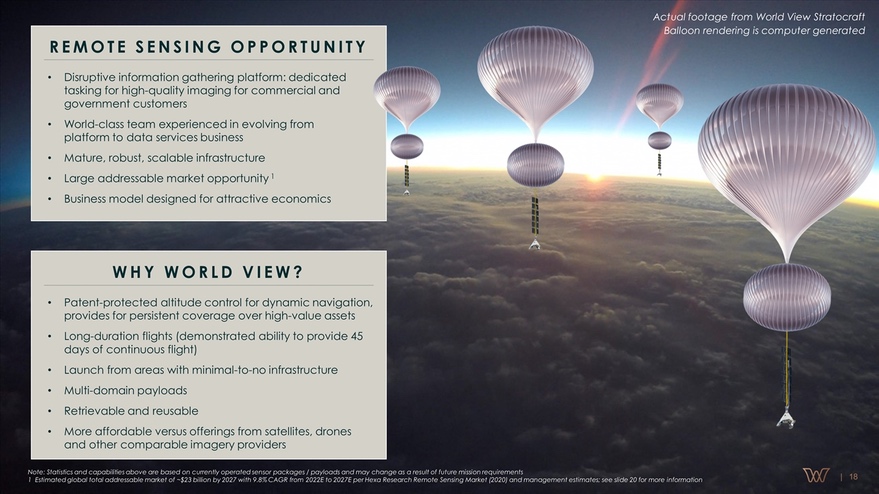WASHINGTON — World View, the stratospheric ballooning company that announced plans to go public last month, is emphasizing remote sensing, and not tourism, as its primary market for the next several years.
The company, which said Jan. 13 it would go public through a merger with a special purpose acquisition company (SPAC) called Leo Holdings Corp. II, filed an investor presentation with the Securities and Exchange Commission Feb. 3 that provided new information about its finances and business plans.
In the presentation, the company described how it believed its balloon platform, called a “stratollite,” could compete against satellites and aerial platforms in providing high-resolution imagery for extended periods.
That capability, it stated in the presentation, fills a “key gap” in the market. “World View has demonstrated 45 days of persistent imaging over areas of interest with 5-7cm GSD (ground sampling distance) versus 30cm from satellites,” it stated. The company says it also offers infrared imaging and is working on a radar payload.
Throughout the presentation, the company emphasized the potential opportunity it sees in the remote sensing market, estimating a global market worth $23 billion by 2027 in sectors ranging from energy to national security. It plans to provide both dedicated balloon flights for those customers as well as “subscriptions,” where the company operates balloons and sells data to multiple customers.
“World View is a premier remote sensing company,” stated the title of one slide in the presentation, citing a “large and growing remote sensing market opportunity.”
That opportunity largely remains a potential one for World View. It did not disclose details about its finances in the SPAC announcement last month, but said in the investor presentation it conducted only four balloon flights in 2022, with total revenue of $3 million.
World View expects both the number of flights and revenue to grow substantially in the next few years, reaching $89 million in revenue from 65 flights in 2025. Adjusted earnings before interest, taxes, depreciation, and amortization (EBITDA) will break even in 2024 according to its projections, reaching $36.5 million in 2025.
The company, which projects $17 million in revenue for 2023 and an adjusted EBITDA loss of $11.6 million, said it has a sales backlog of $7.6 million for 2023. World View didn’t elaborate on that backlog but noted a strategic partnership with Sierra Nevada Corporation (SNC) where SNC will buy a minimum number of flights annually over five years, with the 2023 minimum set at $5 million.
World View, founded a decade ago to provide stratospheric balloon flights for tourists, only to pivot to uncrewed stratollites, announced in October 2021 it would resume development of what it calls the Explorer Space Capsule that can carry 10 people for flights lasting up to 12 hours. When it announced its SPAC merger, the company said more than 1,200 customers had made deposits.
However, while the company has talked about starting flights as soon as 2024, there is little mention of its space tourism plans in the presentation. Tourism, along with research flights and development of remote sensing analytics capabilities, are mentioned as “future applications” in an appendix at the end of the presentation, with no discussion of when the flights would begin or how much revenue they will generate.
In the presentation, World View says its SPAC merger will provide the company with up to about $90 million in cash. It projects getting up to $47 million from the proceeds of the SPAC, assuming no redemptions; many SPAC mergers have high redemption rates as shareholders seek their money back rather than hold stock in the merged company. Another $75 million will come from a separate, concurrent investment called a PIPE. However, $7 million of the proceeds will go to repaying World View debt while approximately $25 million will be spent on merger expenses and fees.
Existing World View shareholders will own 52% of the merged company, with the SPAC sponsors owning 21% and the PIPE investors 17%. The remaining 10% will be owned by the current SPAC shareholders.
